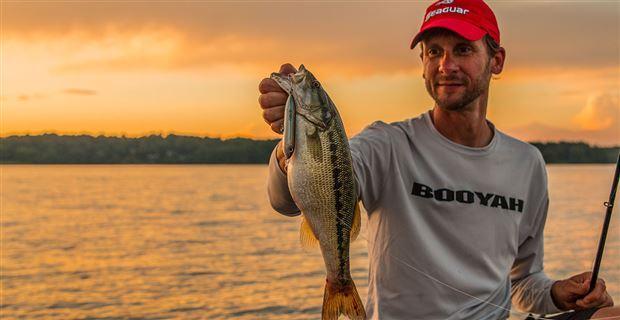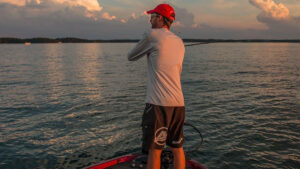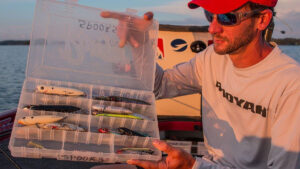When most of us think of bass fishing deep brush piles, bottom-contact presentations most often come to mind. We’ll cast jigs and a wide variety of soft plastics to them because, let’s be honest—it makes total sense. Put your bait in front of the bass and they’ll bite, right?
This time of year, however, something special happens; a topwater fanatic’s dream, if you will. As the bass transition between post-spawn and their true summertime patterns, there’s a short window that can produce some of the most vicious topwater strikes you’ve ever witnessed. Your hands will tremble with excitement, your knees will knock with anticipation and your palms will likely be bloodied by the lips of big bass.
According to professional angler Patrick Bone, this is prime time to be fishing walking topwater lures over deep brush piles. I shared a boat with him recently and I’m telling you—it’s truly a sight to behold. If you take his little-known tips to heart, you can have the time of your life.
To make the most of this annual phenomenon, there are a few things you need to know.
- Why it works
- Finding the right brush
- Lure selection
- Line considerations
Why topwater lures and why now?
Although it has come and gone in many parts of the country, it’s imperative to understand the influence of the spawn on present bass behavior. It’s an awfully rigorous time for them. The females have spent months instinctually preparing their bodies to deposit their brood of eggs and the males have depleted their energy defending the newly hatched fry to the best of their ability.
Immediately after the spawn—commonly referred to the post-spawn period—it can be difficult to make a bass bite. Essentially, they’re wiped out. They need time to rest and recover from the hustle and bustle of the spawning season. But when this short-lived “funk” comes to an end, they have just one thing on their minds. It’s all about food.
“When post-spawn bass finally decide to eat, there’s no turning back,” Bone said. “They desperately need to replenish their bodies, so once they’re rested enough, their feeding behavior is incredibly aggressive. If you were stranded on an island with very little food for a few weeks, you’d be scarfing down anything in your path once you were rescued. This topwater bite is very similar to that. They’re indiscriminately feeding and will travel a long way to inhale your topwater lure.”
So if they’re that ravenous, why wouldn’t they eat a jig or shaky head? According to Bone, it’s all about appealing to their predatory instincts.
“These bass are down there on these brush piles, just sitting there,” Bone said. “Everything is quiet and all of the sudden, out of nowhere—a big ol’ topwater lure comes walking over their heads. It’s all about the element of surprise, in my opinion. Before they can even process it in their minds, their instincts take over and they can’t help but try to kill and eat whatever is making all of the racket. That’s why Kevin VanDam is so good; he forces bass to react. That’s exactly what you’re doing here.”
Water clarity and brush pile location
In order to enjoy consistent success, it’s essential to understand the importance of water clarity when fishing topwater lures over deep brush piles. Unfortunately, this technique doesn’t work on every body of water.
“I’ve tried it until I’m blue in the face, but this bite just doesn’t materialize in stained water,” Bone said. “You’ll need at least 5 feet of visibility in order to make it work. But the clearer water you can find, the more bites you’re going to get. They’ll come up 15 or 20 feet to eat your lure—it’s not that big of a deal to them. That’s what makes this deal so much fun. They have all that room to build up speed, so when they break the surface to eat your plug, they hit it like an absolutely freight train.”
When you find water with a suitable amount of clarity, your next step revolves entirely around finding the “right” brush. Believe it or not, there is such a thing as “good” brush piles and “bad” brush piles.
- Put in the time— There’s really no way around it; finding good brush takes time with your electronics. Because the best piles are usually found in 18 to 20 feet of water, he’ll keep his boat in this depth range while paying close attention to his Lowrance unit. Based on his experience throughout the country, most manmade brush piles are placed in the 20-foot range, so it shouldn’t take very long to find several potential targets.
- Main lake— “I won’t say you can’t find productive brush in the creeks, but I always concentrate on the main lake points and humps when I’m looking for this topwater bite for two primary reasons,” Bone said. “First, that’s where the majority of the bass are heading for the summer, so it makes the most sense. Second and perhaps most importantly, current is a big factor. The fish are there whether there’s current or not, but moving water positions them and makes the lake come alive. The bait starts moving, the bass relate closer to cover and things just start happening. All of this factors in to getting more awesome blow-ups.”
- Let ‘em rest— Bone establishes a rotation of roughly a dozen brush piles in relatively close proximity and fishes them at an astonishing pace. Timing is incredibly important, as I discovered while fishing with him. 99 percent of the time, your bites will come on the first two or three casts due to the surprise element we discussed earlier. If he doesn’t get a bite quickly, he picks up the trolling motor and moves. He will, however, hit the same piles several times throughout a single day—so if you don’t get a bite right away, don’t get give up on a particular area. You can return 30 minutes later and get well in a hurry.
Topwater selection
Everyone has their “thing” in fishing. While a variety of walking topwater lures can elicit strikes over deep brush, Bone’s “thing” is the Heddon Spook.
“This time of year, you’d be hard-pressed to pry a Spook out of my hands,” Bone said. “It’s a major confidence lure for me because it’s directly responsible for some of my best fishing days. It’s built like a tank, it casts a mile and most importantly, it calls ‘em up and causes some unreal topwater explosions.”
There are some caveats, however, to his Spook selection. The weather conditions heavily dictate which lure Bone chooses on a given day. He breaks his selection process down into three categories—sight, sound and size.
- Sight— “Color selection is very important, but I don’t get too carried away with it,” Bone said. “Basically, if it’s sunny, you’re better off using a reflective chrome color to call them up from the depths. In cloudy conditions, I like to use a bone-colored Spook because it gives a more noticeable silhouette for the bass to hone in on. On a nasty, rainy day I’ll actually go with a dark-colored one, perhaps a Black Shiner or something similar.”
- Sound—Bone most often uses two types of Spooks—the original Super Spook and the Chug’n Spook because each of them has a very unique sound as it works across the surface. If he’s fishing on a busy day with lots of recreational boaters or in breezy conditions, he uses the Chug’n Spook due to its noisy water displacement properties. The cupped lip spits and sprays a great deal of water throughout the retrieve, which helps the bass distinguish the lure from other surface commotion. On glass-calm days, he tends to use the original Super Spook due to its more subtle gliding action. Its rattles are still loud enough to “holler ‘em up”, as he jokingly calls it, but they won’t overpower the bass on a relatively quiet day.
- Size— “Big baits do catch big fish,” Bone said. “So I like to use the larger Spooks to start out with. If I can get away with it and get bites, I won’t put it down. If I have a bunch of short-strikes, however, sometimes a simple size change can work wonders. This is when I’ll tie on a Super Spook Jr. and ‘finesse’ them a little more.”
Braid, monofilament or both?
When fishing topwaters over deep brush, your line selection can prove to be critical. Taking fluorocarbon out of the equation due to its sinking properties, an angler has two primary options when choosing the optimal fishing line for this technique—old-school monofilament or new-school braided line. Each has its pros and cons.
- Braid— “Braid is all about having zero stretch,” Bone said. “You’re making really long casts with this technique, so this line does make it much easier to work your lure. But remember, braid is very limp and also floats. This might sound good for a topwater presentation, but it actually results in a lot of tangling. If you have a big one come up and knock your lure into the air, braid tends to tangle around your treble hooks which can deter that fish from coming back a second time.”
- Monofilament— Monofilament line is a popular choice among anglers for topwater fishing due to its excellent hookup ratio and shock absorption, but its elasticity can also make for a long day of fishing. After bombing a cast across a brush pile, the added stretch in the line makes more aggressive, downward rod twitches necessary to transfer the energy to your lure. It’s still doable, but it can wear you out quickly.
- The solution— “In my opinion, the perfect setup is a combination of braided line and monofilament,” Bone said. “You essentially get the best of both worlds. I use 40-pound Seaguar Smackdown Braided Line for my main line and attach a 6-foot, 15-pound Seaguar Senshi Monofilament leader. You can work the bait easier due to the braid, but that mono gives you a good hookup, a little more shock absorption when a big one digs at the boat and it also gives you lure a more natural presentation in the clear water. I don’t wanted a rope laying across the surface if I can help it.”
When you notice the post-spawn bass starting to “wake up” and resume their feeding activities, you owe it to yourself to try this technique. It will seem crazy… until you get that first bite. Spend some time finding clear water and some brush piles in the 20-foot range, tie on a big topwater lure and start bombing some casts. You’ll have an incredible time.















